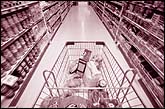It’s a jungle out there – at your local supermarket, that is. Aisles that seem to go on for miles stocked high with every brand of product you could possibly imagine. And while new merchandise simply seems to appear to replace the old in time for your weekly shopping trip, a lot is actually going on behind the scenes. Food and other consumer goods manufacturers know that more than 70% of purchase decisions are made in the stores. They want to be tuned into retailers’ marketing and selling strategies. On the flip side, retailers have a job to do – sell products. They, too, benefit from measurements of their sales performances. Wharton marketing professor
Using data from 19 food categories sold in 85 major supermarket chains operating in the largest 50 retail markets in the U.S., the research shows that the best performing retailers offer broader assortments, have strong private label programs, charge significantly lower everyday prices and use feature advertising to drive store traffic and display advertising to increase in-store purchases.
So all retailers may as well implement these strategies and they will sell, sell, sell, right? Not quite. Hoch’s research finds that the formula to success is a bit more complex. It involves implementing a formal category management process, in which retailers consider a category as a whole, rather than focusing on individual brands or products. “In some sense, it’s obvious why some retailers do better than others; they try harder,” explains Hoch. “What this paper tries to do is say that the way to try harder depends upon the product category. Retailers don’t want to blindly spend scarce resources. They need to be selective in how they spend depending on the role of the category for the retailer and for the consumer.”
The role to which Hoch refers specifies whether a particular category is either a staple, a niche, a variety enhancer or a fill-in product at the supermarket. Staples are items like milk and coffee that consumers buy frequently; variety enhancer items include products like pickles and rice that a lot of people buy, but not so often; niche items such as yogurt and macaroni and cheese are bought frequently by fewer people; and fill-in products include vinegar or pancake mix, items that only a few interested consumers buy infrequently.
With these roles in mind, Hoch makes several conclusions about the impact of price, promotion and assortment, those variables that determine which retailers perform the best. For instance, he says, staples are influenced by three key drivers. “We found in the staples category that temporary price discounts do improve category performance as do feature and display advertising. The reason for this is because consumers are coming to the store each week to buy staples. But on the flip side, having bigger assortments of these staple products doesn’t really matter. Stores don’t need to carry more of them because they are already so prominent.” Similar to staples, each of the remaining three product “roles” have their own varying demographics, so to speak. Niche products benefit a lot more from larger assortments because each segment has their own peculiar set of tastes, and so on.
While price, promotion and assortment variables are linked closely to the role a particular category plays in the store portfolio, Hoch and his colleagues conclude that retailers with strong store brand performance do better overall. “The retailer with the strong store brand program is in some sense in better control of his own destiny,” suggests Hoch. “He has to do everything the national brands do, market the product, source the product and sometimes create the packaging. We found that the investment does pay back in terms of better performance.”
Hoch’s research in “Why Retailers Sell More or Less Than Their Fair Share in a Category” is useful to both retailers as well as manufacturers. Retailers are able to identify the best practices in each of the different kinds of categories within their overall retailer portfolio. Meanwhile the manufacturers, though traditionally very brand-oriented, can also benefit from research explaining the influence of category management on overall performance. Not only will better retailer performance in a particular category help them get the lion’s share of growth, especially if they dominate in that category, it will also help them determine how they want to allocate their resources. Says Hoch: “Manufacturers might use these relative performance measures for retailers to invest more money with the retailers who perform the best, or they could try to improve the performance of the poorer-performing retailers.”
So the next time you head for the dairy aisle during your weekly trip to the supermarket, recognize that to retailers and manufacturers, it’s more than just a pretty carton of milk.



